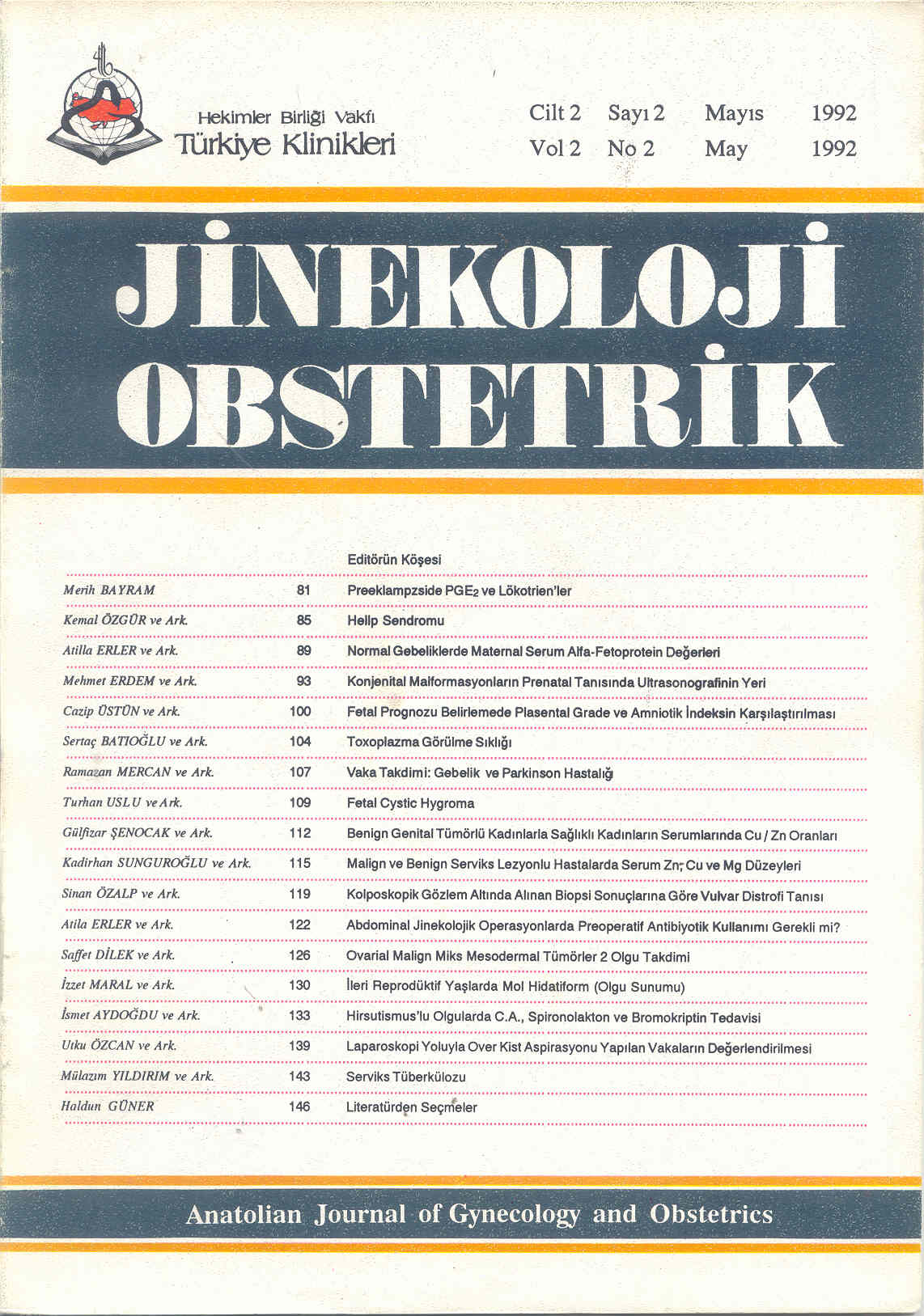Open Access
Peer Reviewed
ARTICLES
3754 Viewed1501 Downloaded
Hydatiform Mole In Advanced Reproductive Ages (Case Report)
İleri Reprodüktif Yaşlarda Mol Hidatiform (Olgu Sunumu)
Turkiye Klinikleri J Gynecol Obst. 1992;2(2):130-2
Article Language: TR
Copyright Ⓒ 2025 by Türkiye Klinikleri. This is an open access article under the CC BY-NC-ND license (http://creativecommons.org/licenses/by-nc-nd/4.0/)
ÖZET
Mol hidatiform en sık rastlanan gestasyonel trofoblastik hastalıktır. İnsidansı 1/1500'den 1/125'e kadar değişmektedir. Sıklığı 20 yaş altında ve 40 yaş üzerinde artmaktadır. Kliniğimize vaginal kanama yakınması ile başvuran 50 ve 47 yaşlarındaki iki hastaya probe küretaj yapıldı. Histopatolojik sonuçları mol hidatiform olarak gelen hastalara total abdominal histerektomi ve bilateral salpingooferektomi uygulandı. İlk hastamızın b-hCG titrelerinde postoperatif dönemde yükselme tespit edilmesi üzerine kemoterapiye başlandı. Bu çalışmada, ileri reprodüktif yaşlarda görülen iki mol hidatiform olgusu sunulmuş ve ayırıcı tanıları tartışılmıştır.
Mol hidatiform en sık rastlanan gestasyonel trofoblastik hastalıktır. İnsidansı 1/1500'den 1/125'e kadar değişmektedir. Sıklığı 20 yaş altında ve 40 yaş üzerinde artmaktadır. Kliniğimize vaginal kanama yakınması ile başvuran 50 ve 47 yaşlarındaki iki hastaya probe küretaj yapıldı. Histopatolojik sonuçları mol hidatiform olarak gelen hastalara total abdominal histerektomi ve bilateral salpingooferektomi uygulandı. İlk hastamızın b-hCG titrelerinde postoperatif dönemde yükselme tespit edilmesi üzerine kemoterapiye başlandı. Bu çalışmada, ileri reprodüktif yaşlarda görülen iki mol hidatiform olgusu sunulmuş ve ayırıcı tanıları tartışılmıştır.
ANAHTAR KELİMELER: Gestasyonel trofoblastik hastalık, mol hidatiform
ABSTRACT
Hydatiform mole is the most common gestatitional trophoblastic neoplasia. ITs incidence varies worldwide from 1/1500 to 1/125 deliveries. The incidence is higher in women under 20 and over 40 years of age. Two patients with a complaint of vaginal bleeding admitted to our clinic. They were 50 and 47 years old. We performed probe curettage in these patients. A a result of pathologic examination, these cases were reported hydatiform mole. They were treated by abdominal hysterectomy and bilateral salpingooferectomy. Following the surgery, we began the chemotherapy in first case who was gradually increased her b-hCG titers in postoperative period. In this study, these cases with hydatiform mole in advanced reproductive ages is presented and its differential diagnosis is discussed.
Hydatiform mole is the most common gestatitional trophoblastic neoplasia. ITs incidence varies worldwide from 1/1500 to 1/125 deliveries. The incidence is higher in women under 20 and over 40 years of age. Two patients with a complaint of vaginal bleeding admitted to our clinic. They were 50 and 47 years old. We performed probe curettage in these patients. A a result of pathologic examination, these cases were reported hydatiform mole. They were treated by abdominal hysterectomy and bilateral salpingooferectomy. Following the surgery, we began the chemotherapy in first case who was gradually increased her b-hCG titers in postoperative period. In this study, these cases with hydatiform mole in advanced reproductive ages is presented and its differential diagnosis is discussed.
MENU
POPULAR ARTICLES
MOST DOWNLOADED ARTICLES





This journal is licensed under a Creative Commons Attribution-NonCommercial-NoDerivatives 4.0 International License.










